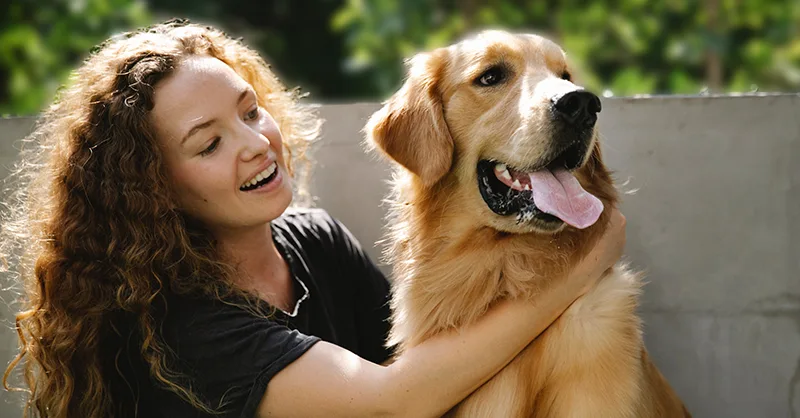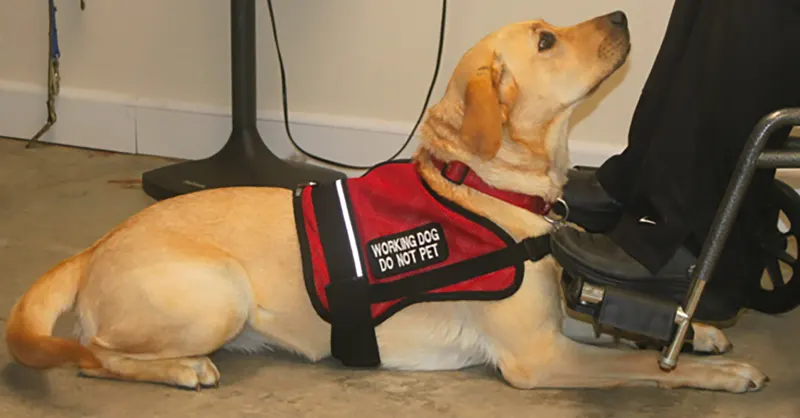Archive for the ‘Service Dog Tips’ Category
Service dogs are always working to ensure and protect the welfare of their human handler. Therefore, these dogs can experience and accumulate a lot of stress each day. It’s essential for handlers to recognize signs of stress for their service dogs, and to understand ways of preventing and lowering stress for these animals. This allows them to continue performing their tasks and duties under the highest conditions of health and wellness possible. Ensuring and protecting the welfare of service dogs is as important as the work they do for their humans.
Stress Signs for Service DogsSince they can’t communicate with words, service dogs exhibit signs of stress through their bodies and behaviors. Here is a list of stress signs to watch for in a service dog:
Eye/Look Indicators Avoiding eye contact Blinking Breaking eye contact Dilated eyes Frequent looks for direction Glazed look Looking away Quick eye movements Red eyes (sign of increased blood pressure) Showing whites of eyes (Whale Eye) Squinting Staring directly Mouth Indicators Air snapping Drooling Flicking tongue Licking lips Nose licking Panting too wide or shallow breathing Showing teeth Whiskers pricked forward or slicked back Yawning Head/Ear Indicators Burying head Ears held up Furrowed brow Laying ears back Quick head movements Scowling look Turning head away Uneven ears Vocal Indicators Barking excessively Growling Screaming Sharp yipping Whining Body Indicators Freezing Hiding Lowered tail (if this is unusual) Raised tail (if this is unusual) Shaking off Stiff posture or walk Stretching Trembling Turning away Other Indicators Bladder problems Bowel problems Chewing themselves Clenching toes Digging Excessive gas Hiding behind human partner Injuring self Leaning or bumping into human partner Lethargy Non-response Poking or shoving handler repeatedly Red pigmentation of skin, ears, or eyes Refusal to eat Scratching self Seeking attention Sniffing Spinning in circles Sweaty or moist paw prints on floor Unusually loose stool Weight loss How to Prevent Stress in Service DogsIt’s essential to prevent stress in the life of any animal as much as possible. This is even more true for service dogs due to the fact that their lives are quite different from their pet dog counterparts.
Relaxation time not only compensates them for their service, but it allows their needs to be prioritized which can help to prevent stress. Relaxation periods should not be paired with working obligations but should be a time of freedom and play. This allows service dogs a much needed and deserved break from not only performing tasks but being at the ready to do so in each moment.
In addition to relaxation time, stress in service dogs can also be prevented through caring for their health and wellness. Since service dogs are committed and devoted to their human handlers, their own level of health and wellness must be excellent in terms of nutrition, veterinary care, grooming, etc. If the comprehensive health needs of service dogs are met, this allows them to perform their duties without the added stresses of feeling unwell physically, mentally, or emotionally.
Exercise is extremely important for the well-being of all dogs, and especially service dogs. Experts recommend at least 30 minutes per day of dedicated exercise for service dogs. Not only does exercise keep service dogs in good health, it also helps to prevent stress from building up throughout each day and over a prolonged period of attentive work.
How to Lower Stress in Service DogsThere may be times when stress in service dogs in unpreventable and unavoidable. During these times, it’s essential to lower stress in service dogs as much as possible.
If you notice that a particular environment or set of circumstances is causing your service dog to show signs of stress, it’s wise to remove them from the situation if possible. This will give them a chance to regain their calm and focus. If there is a situation in which your service dog repeatedly reacts with stress signals, a different approach to training may be required for them to adjust without feeling anxious.
Do not attempt to comfort your dog if they are stressed. This may reinforce your service dog’s fear and they may react negatively to the stressor in the future. If you must show affection or praise, have your service dog perform a command or task first. Provide affection and praise when a desirable behavior has been displayed.
Some dogs may respond well to fast paced commands or “doodle work” when feeling stressed. The thinking behind this is that issuing quick simple commands can get your dog into a different mindset.
ConclusionIt’s important for handlers to be consistent and frequent in offering reinforcement. Service dogs are highly intuitive to their performance, and they rely on reinforcement from their human partner to understand that they are doing their job effectively. Reinforcement that is inconsistent or withheld can result in confusion, which leads to stress.
Overall, one of the best ways to lower stress in service dogs is for their handlers to cope with and react to stress in as calm a manner as possible. This can be very difficult for people with disabilities. However, service dogs are trained to monitor the slightest mood alterations or levels of stress in their human partners. Persistent, heightened stress on the part of their human handlers can result in persistent, heightened stress in service dogs. This level of stress takes its toll on the dog, their ability to perform tasks, and their overall well-being.
Service dogs are more than a man’s best friend; they can be a man’s lifesaver. Mobility service dogs or mobility assistance dogs, in particular, save lives and improve a disabled person’s quality of life. Whether it is preventing their handler from falling or carrying objects to their handler, mobility service dogs open up a world that would otherwise be, quite literally, out of their handler’s reach.
Table of Contents What Does a Mobility Service Dog Do? Mobility Assistance Tasks Emergency Assistance Tasks How Big Should a Mobility Service Dog Be? How Long Does It Take to Train a Mobility Service Dog? Who Can Benefit From a Mobility Service Dog? What Does a Mobility Service Dog Do?Mobility service dogs, also known as brace service dogs or Brace and Mobility Support Dogs (BMSD), are trained to help their owner moving around or obtaining items. These assistance animals receive additional training to perform tasks that make the life of individuals with mobility issues easier.
Mobility Assistance TasksMobility service dogs can help to “brace” their owner. Bracing means helping to keep a person from falling or to assist them to sit or stand upright. Other tasks a mobility service dog can do are:
Opening and closing exit doors and cabinet doors, sometimes by using ropes or special latches. Pushing buttons and flipping light switches when needed. For instance, when in an elevator or automated door. Fetching, carrying, or placing items down when told, particularly in situations when things are out of reach. Assisting a person in a wheelchair. Provide physical support by maintaining balance when their owner feels weak, dizzy, or if they are prone to falling. Assists their owner to stand up or remain upright by physically bracing them or pushing and pulling them. Serve as a counterbalance or assist their owner in walking in a straight line to avoid bumping into things.A mobility service dog can change the world for a person with mobility issues, enabling them to perform daily living activities.
– ServiceDogCertifications.org
Emergency Assistance TasksIn cases of emergency or if their owner falls mobility dogs are trained to react in the following ways:
Bark to notify bystanders or other people in the home of an emergency and the need for assistance. Initiates call to 911, opens the door, or barks to alert first responders where their owner is located. Retrieve emergency medication. Stand over their owner to prevent them from being injured or stepped on. Nudge their owner into a recovery or safety position. Perform emergency tasks such as removing their owner’s clothing during temperature spikes or warming them during rapid temperature drops.Finally, as with all dogs, mobility service dogs offer companionship, loyalty, and connection to their owners—which can help lift their owner’s spirits.
How Big Should a Mobility Service Dog Be?Ideally, an owner shouldn’t place their full weight on their mobility assistance animal. However, because unforeseen events do happen, a service dog should be a larger-statured dog to safely perform their tasks, with both their well-being and their owner’s safety in mind. According to the International Association of Assistance Dog Partners (IAADP), a mobility assistance animal should be at least 22″ tall and weigh at least 55 pounds to assist a child or a petite woman. For average adults, a service dog assisting with mobility should be over 60 pounds.
The size of a mobility service dog ultimately depends on the size and needs of the person they’re working for. For example, a dog required only for retrieval purposes and not for falls assistance can be smaller. Service dogs used for bracing falls, however, may need to be 27 inches or taller, depending on the height of their owner. Ensuring that the dog’s size is compatible with the job required will keep both the dog and the owner safe.
The size of the mobility service dog depends on the tasks they will need to perform in order to help their owner overcome the hardship of the disability. How Long Does It Take to Train a Mobility Service Dog?Knowing how vital and life-changing the work of a mobility service dog is, it’s no wonder that these working dogs require extensive training. Unfortunately, there is no way to obtain a quality service dog quickly or cheaply. According to IAADP, training a mobility service dog may take a minimum of 120 hours of training. Depending on the skills necessary, service dog training may take at least six months. An additional 30 hours of training in a public setting also helps a mobility service dog execute their skills in a community environment without being intrusive with others.
Who Can Benefit From a Mobility Service Dog?As mobility service dogs have a wide variety of skills, they’re ideal for helping with many disabilities and disorders. The following are examples of a few conditions that can benefit from a mobility service dog:
Arthritis Spinal Cord Injury Vertigo Migraine Visual Impairment Brain injury Heart Disorders Muscular Dystrophy Parkinson’s Disease Gait ProblemsIf you or someone you love suffers from any of these conditions, a mobility service dog may be the right choice.
Show everyone your mobility service dog is an important part of your daily life with your Service Dog ID. Get your mobility service dog registered below.
There’s no doubt that modern treatments have come a long way in improving the quality of life for people with disabilities. Technology also offers new gadgets to help make daily life a little less challenging for disabled individuals. With all these advances, however, nothing compares to the help of a service dog. To understand what a service dog is and what disabilities qualify you for a service dog, read on below.
What is a Service Dog?Service dogs receive special training to perform particular tasks tailored to the needs of their owner. Unlike pets, the primary reason for the animal’s presence is to accomplish daily tasks for a person with a disability. Because service dogs are so vital to an individual’s well-being and functioning, their presence is protected under the Americans with Disabilities Act (ADA).
Service dogs are not only exceptionally well-trained, but they are also selected for their intelligence and temperament. As federal law allows service dogs to follow their owners into areas not usually allowed by pets, service dogs are trained to behave and be safe in public. For someone with a disability, getting a service dog can be life-changing. Some people with a disability can experience more freedom and independence thanks to their service dogs.
Qualified Disabilities for a Service DogIf you’re curious about getting a service dog for yourself or someone you love, your first step would be to understand if your disability qualifies you for a service dog.
How is a Disability Defined?According to the ADA, a disability is defined as:
“Any physiological disorder or condition, cosmetic disfigurement, or anatomical loss affecting one or more of the following body systems: neurological, musculoskeletal, special sense organs, respiratory (including speech organs), cardiovascular, reproductive, digestive, genitourinary, hemic and lymphatic, skin, and endocrine.”
Interestingly, the ADA definition of a disability is both vague and specific at the same time for a reason. It attempts to encompass all the possible disabilities a person may have without creating a broad definition to include everyone. People who have disabilities require specific accommodations. The ADA’s definition of a disability means that a person can be considered disabled for both mental or physical problems.
Having a disability is the first part of being qualified for a service dog. The second is whether a service dog can meet the needs of a disability.
A wide range of disabilities qualifies for a service dog to help their owner improve their quality of life. Service Dogs and DisabilitiesNot every disability qualifies a person for a service dog. A physician can assess a person’s needs and make an individual assessment as to whether a service dog is beneficial in their situation. Here are a few examples of disabilities that may qualify:
ArthritisService dogs can help people with mobility issues by obtaining daily items that they would not get for themselves. For example, these dogs can hand over objects on the floor or help owners slip on their shoes.
AutismService dogs can help children with autism remain safe, provide guidance, and encourage tactile stimulations. These dogs also monitor boundaries for a child and can alert others of a child is harming themselves.
BlindnessService dogs can guide visually impaired individuals through streets and crowded areas, navigating them through situations that would otherwise be dangerous. These dogs can also alert their owners to safety issues and remove fall hazards from their path.
DiabetesService dogs can detect low blood sugar in people with diabetes and inform their owners to take precautions. These dogs can also call 911 in emergencies and obtain life-saving medication during hypoglycemic events.
Seizure/EpilepsyService dogs can help to prevent or assist in situations where seizures occur. These dogs can alert owners of impending seizures and place pressure on body parts for safety when seizures happen.
Psychiatric DisordersPsychiatric service dogs can help obtain medication for people with psychiatric disorders, discourage self-injurious behavior, and deter their owners from situations that may trigger a crisis response.
Other Disabilities That Can Benefit From Service Dogs Asthma Cerebral Palsy Chronic back/neck problems Chronic Fatigue Fibromyalgia Hearing Impairments Heart Problems Multiple Sclerosis Narcolepsy Paralysis StrokeIf you don’t see your disorder on this list, talk to your licensed therapist if a service dog may benefit you. There are many other disabilities that can qualify for a service dog, depending on the individual’s needs.
A service dog can assist individuals with a qualifying disability in all public areas. Do You Qualify for a Service Dog?Because service dogs perform such an essential duty, they can follow their owners into all public areas. This allows them to perform their tasks whenever their owners need them. A service dog must be well-behaved and safe with the public at all times. These responsibilities are why service dogs go through such a rigorous selection and training process. To qualify for one of these special dogs depends on your disability, individual status, and physician. Evaluate your daily needs and start a conversation with your practitioner about how a service dog can improve your quality of life.







